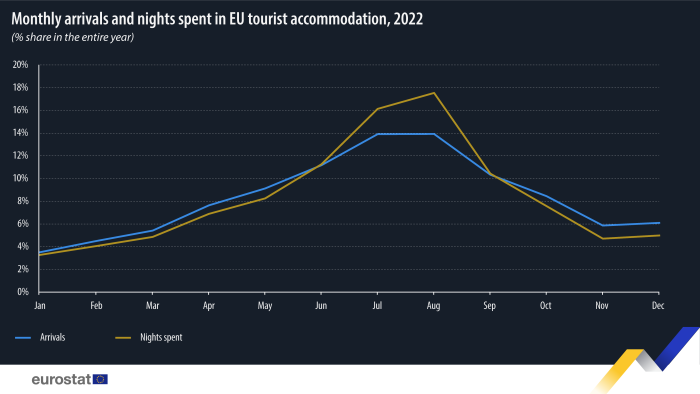Seasonality in the tourist accommodation sector
Data extracted in May 2023.
Planned article update: 28 May 2024.
Highlights
Over a third of tourism nights in 2022 were spent in July and August.
Tourism nights spent at campsites were heavily concentrated in the third quarter of 2022 (66% of the annual nights).
Strongest tourism seasonality in 2022 observed in Croatia, Greece, Bulgaria, Albania and Montenegro.
This article focuses on the tourist accommodation sector in the European Union (EU) Member States, candidate and EFTA countries and looks at the seasonality of arrivals and nights spent in accommodation establishments.
This analysis from the point of view of the supply side complements another article on seasonality in tourism demand in which the seasonal bias in tourism trips of Europeans is discussed. The most recent monthly data on tourist accommodation can be found in the article "Tourism statistics - nights spent at tourist accommodation establishments".
Full article
Arrivals and nights spent in tourist accommodation
July and August accounted for 34 % of all annual nights spent in EU tourist accommodation in 2022
Many tourist activities have always been highly seasonal. Leading reasons are environmental factors, such as climate conditions or geographical location, together with social and cultural factors, such as school holidays. During peak vacation times, tourist areas may face overcrowding and resource strain. Conversely, quieter periods can lead to underutilised facilities and job instability due to fluctuating demand.
Figure 1 and Table 1 summarise the monthly data and seasonal pattern in 2022. The most popular months were August (18 % of all nights spent at EU tourist accommodation in 2022, corresponding to 478 million nights spent) and July (16 %, 440 million nights). The number of nights spent during these two summer months was nearly five times higher than in the off-peak months January and February (recording respectively 89 million and 111 million nights spent). Figure 1 shows that the seasonal pattern for nights spent was a bit more pronounced than for arrivals, suggesting that the length of stay is longer during these busier months, likely corresponding with many tourists' main holiday period.
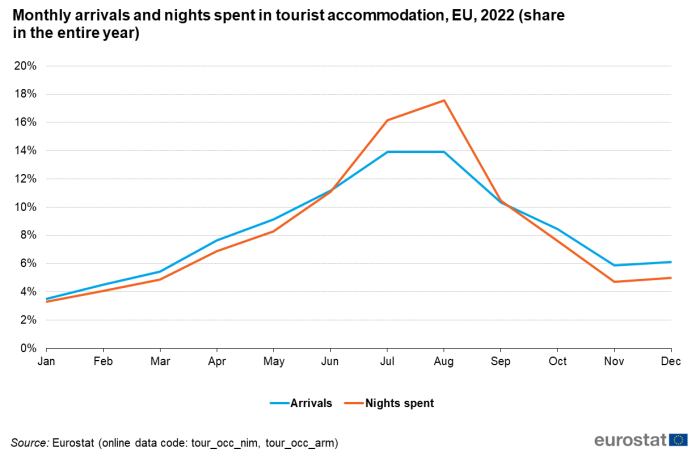
Source: Eurostat (tour_occ_nim) (tour_occ_arm)
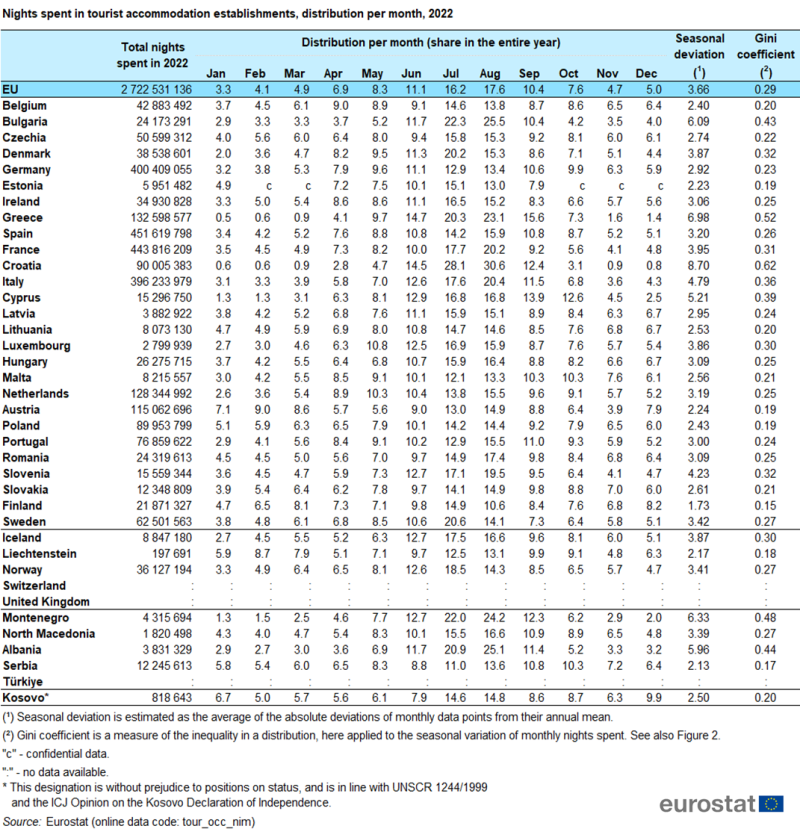
Source: Eurostat (tour_occ_nim)
Wide variety of seasonality measures
Independently of the method used, Croatia recorded the highest seasonality
A first approach is the Gini coefficient, measuring the inequality in a frequency distribution. Originally used to study income inequality, it can also be applied to tourism seasonality. A detailed discussion on the Gini coefficient is outside the scope of this article, but it basically measures the difference between the cumulative share of monthly nights spent (ranking the months from slowest to peak) and the distribution in absence of seasonality (or uniform distribution of the annual nights spent over the twelve months), as illustrated in Figure 2. The value of this seasonality measure is shown for all countries in Figure 3a and in the last column of Table 1. The discrepancy between the observed seasonality and a situation without any seasonality was twice as high in Croatia (0.62) compared with the EU average (0.29). High seasonality was also observed in Greece and Bulgaria.
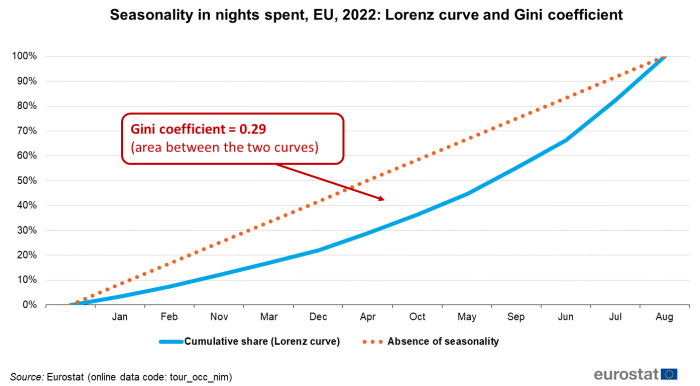
Source: Eurostat (tour_occ_nim)

Gini coefficient
Source: Eurostat (tour_occ_nim)
A second approach looks at the share of the two dominant months in the annual number of nights spent and is shown in Figure 3b and Table 2. While this measure is more intuitive for users, it can be affected by extreme values in the peak month(s). The seasonal pattern was most pronounced in Croatia (59 % of nights spent in 2022 were recorded in July and August), Bulgaria (48 %) and Greece (43 %). Meanwhile, the seasonal pattern was least pronounced in Malta and Finland (both 25 %), Germany (26 %) and Austria (28 %).
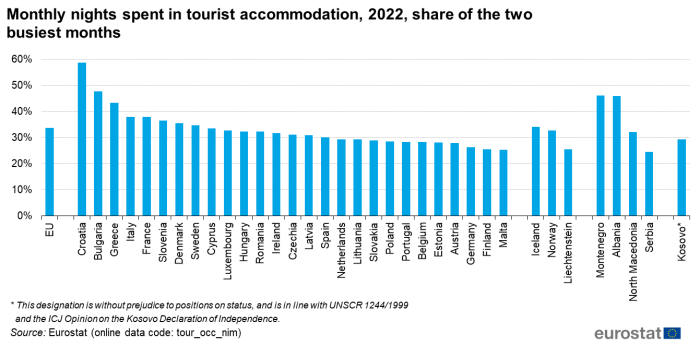
share of the two busiest months
Source: Eurostat (tour_occ_nim)
A third approach is the seasonal deviation, defined as the average of the (absolute) deviations of the monthly data points from their annual mean. The highest seasonal deviations in 2022, as shown in Figure 3c and Table 1 (last but one column), were observed in Croatia and Greece, with 8.7 and 7.0 points respectively.
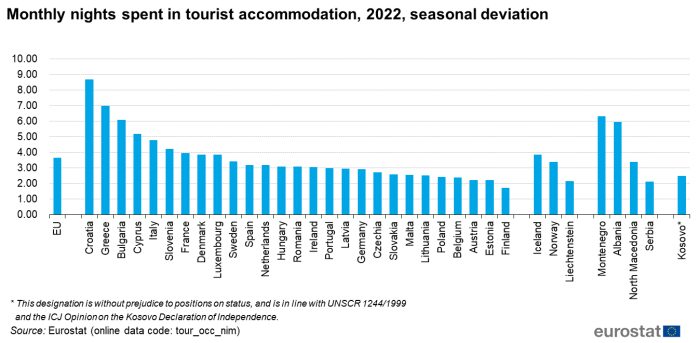
seasonal deviation
Source: Eurostat (tour_occ_nim)
Finally, one can look at the difference between the peak and bottom month, although this peak/bottom ratio can be strongly influenced by extreme values in those two months, ignoring the seasonal pattern in the remaining ten months. Table 3 shows that at EU level, the number of nights spent in the peak month (August, 478 million nights) was 5.3 times higher than in the bottom month (January, 89 million). For Croatia, this ratio was 54.5, while for Greece it was 44.6. But for Bulgaria, the other highly seasonal country, the difference between the peak and bottom month was, at 8.8, less pronounced.
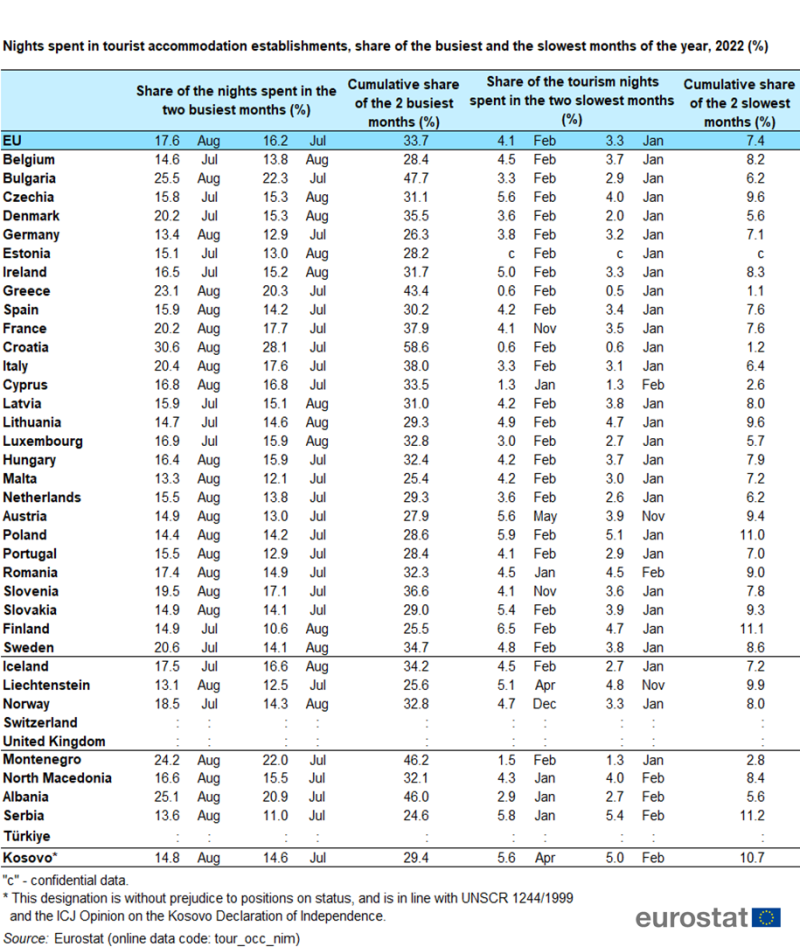
Source: Eurostat (tour_occ_nim)

Source: Eurostat (tour_occ_nim)
Seasonality at country level
Different seasonal impact across Europe
The overall observation that July and August are the peak months for EU tourism holds for all countries. Table 2 shows that in all countries these two summer months are dominant. In 17 EU Member States, most tourism nights were spent in August. In 10 EU Member States July was the month with the highest number of nights spent (see also Table 3).
However, the significance of July and August was not the same in all countries. In Croatia, nearly 60 % of all nights spent in 2022 were recorded in these two months. Also in Greece and Bulgaria, July and August accounted for more than 40 % of the annual tourism nights. In Malta, Finland, Germany and Austria, around 1 in 4 tourism nights was observed in July or August.
The different seasonal patterns in these countries is illustrated in Figure 4, showing the near-absence of tourism flows during the winter months in the highly seasonal countries (with January, February, March, November and December jointly accounting for 5 % or less of the annual nights spent). Countries with skiing tourism, like Austria and Finland, can benefit from a second, albeit smaller, peak in the winter to obtain a better spread of tourism flows throughout the year.
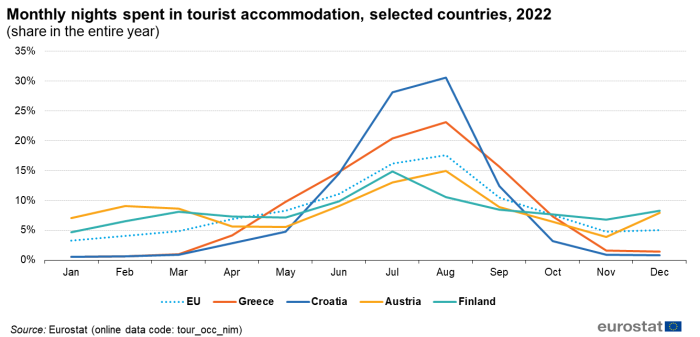
(% share in the entire year)
Source: Eurostat (tour_occ_nim)
Given the large variety of tourism destinations, even within a country, it is relevant to analyse the seasonality of tourism not only at the country level, but also at the regional level. At the time of writing of this article, monthly data at regional level for 2022 was not yet available, but for a regional analysis of seasonality, please consult the article "Tourism statistics - seasonality at regional level"
Seasonality by type of accommodation
Two-thirds of nights spent at campsites were recorded in the third quarter
In the previous sections, the tourist accommodation sector was analysed as a whole. The breakdown by type of accommodation shown in Figure 5 and Table 4 reveals that seasonal fluctuations were less prominent for hotels than for other tourist accommodation. The sharpest summer peak was registered in campsites (including recreational vehicle parks and trailer parks), which depend much more on the weather and are often closed in winter.
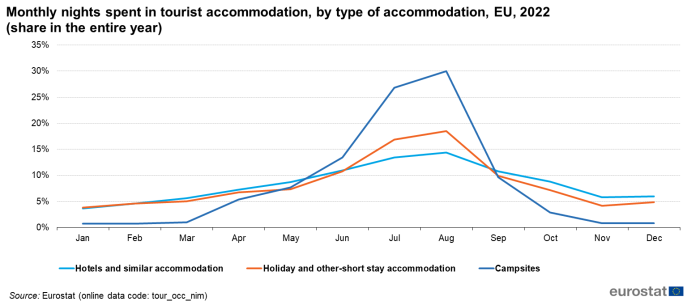
Source: Eurostat (tour_occ_nim)
The third quarter, spanning the summer months July, August and September, was the peak season for all three types of accommodation considered. This was the case in all countries. The dominance of the summer quarter was, however, much stronger for the campsites, with two thirds of all nights spent recorded during those three months, with almost non-existent tourism flows in the first and fourth quarter (respectively 2 % and 5 % of the annual nights spent). For the hotels segment, the third quarter accounted for 39 % of the nights spent in 2022, for the segment of holiday and other short-stay accommodation this was 45 %.
In three EU Member States - Bulgaria, Croatia and Greece - hotels had to rely on the third quarter for more than half of their overnight stays. This was also true for Montenegro and Albania. The dependency on the third quarter was very high for campsites in Czechia, Poland, Slovakia, Iceland, Montenegro and North Macedonia, with less than 1 in 5 tourism nights observed outside that quarter.

Source: Eurostat (tour_occ_nim)
Seasonality by origin of the guest
Slightly longer summer season in the segment of foreign tourists
Figure 6 and Table 5 show the spread of nights spent throughout the year, separately for domestic guests and for international tourists. Although no significant differences in seasonal patterns for these two tourist flows can be observed for 2022, the August peak was a bit more pronounced for domestic tourism flows. Still, the share of the third quarter in the annual nights spent was slightly higher for the foreign segment (46 %) than for the domestic segment (43 %), partly due to the main seasons extending more significantly into September for foreign tourists (with September accounting for 12 % of the annual nights spent by foreigners, compared with 9 % for domestic tourism flows). This relatively sharper drop in September, can also be observed in Figure 5, but in general the distribution of nights spent by domestic and by international tourists broadly followed the same pattern.
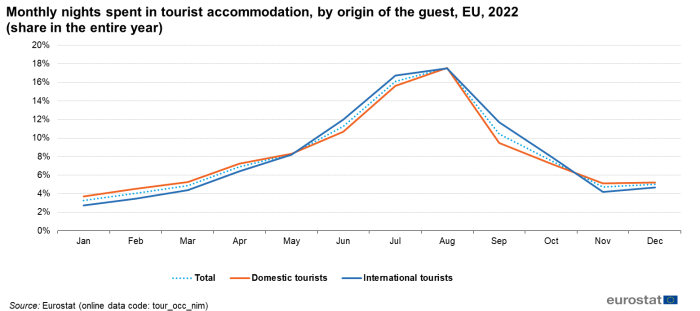
Source: Eurostat (tour_occ_nim)
In the countries identified earlier as having a strong seasonal bias in the accommodation sector, there were large differences between the spread of domestic and international guests over the four quarters of the year. For instance, in Croatia 73 % of foreign nights spent were recorded in the third quarter. The first and fourth quarter combined, accounted for only 6 % of the annual nights spent by international tourists in Croatia, compared with 22 % for Croatian residents travelling in Croatia.

Source: Eurostat (tour_occ_nim)
Source data for tables and graphs
Data sources
Regulation (EU) No 692/2011 concerning European statistics on tourism, organises the European statistical system of tourism statistics. This system consists of two main components: statistics on capacity and occupancy of tourist accommodation and statistics on tourism demand. The former are collected in most EU Member States via surveys filled in by accommodation establishments, while the latter are mostly collected by means of traveller surveys at the border or via traditional household surveys.
Statistics on the occupancy of tourist accommodation refer to the number of arrivals (at accommodation establishments) and the number of nights spent by residents and non-residents, broken down by type of establishment or by region. Both annual and monthly series are available. Statistics on the use of bedplaces and bedrooms (occupancy rates) are also compiled.
Statistics on the demand for tourism look at participation, i.e. the number of residents that make at least one trip of at least one overnight stay during the reference period. They also look at the number of tourism trips made (and the number of nights spent on those trips), broken down by tourism-related variables such as country of destination, month of departure, length of stay, type of organisation of the trip, mode of transport, type of accommodation or expenditure, and by socio-demographic variables, such as age or gender.
Context
In June 2010, the European Commission released a Communication entitled Europe, the world's No 1 tourist destination - a new political framework for tourism in Europe. One of the challenges and opportunities facing the European tourism industry is the seasonal distribution of demand for tourism. Better use of existing tourist infrastructure and staff in the low season could help businesses improve their productivity and benefit from a more stable and motivated workforce. Extending the tourism season or spreading tourism activities more evenly throughout the year can boost the sustainability and competitiveness of European tourist destinations.
Direct access to
Main tables
- Tourism (t_tour)
- Capacity and occupancy of tourist accommodation establishments (ESMS metadata file — tour_occ_esms)
- Regulation (EU) No 692/2011 of the European Parliament and of the Council of 6 July 2011 concerning European statistics on tourism and repealing Council Directive 95/57/EC. (Summary)
- Commission Implementing Regulation (EU) No 1051/2011 of 20 October 2011 implementing Regulation (EU) No 692/2011 of the European Parliament and of the Council concerning European statistics on tourism, as regards the structure of the quality reports and the transmission of the data.
- Agenda for a sustainable and competitive European tourism (Communication from the European Commission, October 2007)
- European Commission - Directorate-General for Internal Market, Industry, Entrepreneurship and SMEs - Tourism
